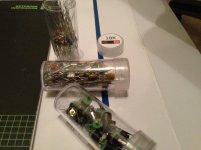When you pick out your multi compartment parts bins, make sure that the little drawers are flexible. The flexible ones are usually opaque. The clear, hard plastic ones crack with very little use.
Thanks for all the replies. I have some time yet to figure it out. I had a couple jobs come up that will be eating away the free time I had to build.
Such is life. LOL
Such is life. LOL
DreadPirate
That is usually my experience as well. Those clear drawers do not hold up to me at all. Most common for me is the back of the drawer cracks where it meets the stop and runs down the back.
Not a huge deal for machine screws and cotton pins, but I can already see things getting fubar'd with resistor wires sticking through the cracks.
That is usually my experience as well. Those clear drawers do not hold up to me at all. Most common for me is the back of the drawer cracks where it meets the stop and runs down the back.
Not a huge deal for machine screws and cotton pins, but I can already see things getting fubar'd with resistor wires sticking through the cracks.
The focus has for the most part been on through-hole components. I have some drawers for larger parts, and use the small envelope method for resistors, which works great for me. Any ideas to add here on storage of SMT resistors, caps, transistors?
For smaller parts I got a good deal on some quarter storage tubes that have worked out great.
Attachments
I've seen photos where folks used clear plastic photo album pages (with the "pockets" where you put the print or 35mm slide), especially for components still in their embossed paper tape, but I've always been afraid of ESD from those products.. . . Any ideas to add here on storage of SMT resistors, caps, transistors?
Dale
- Status
- Not open for further replies.
- Home
- Design & Build
- Parts
- Parts Storage

